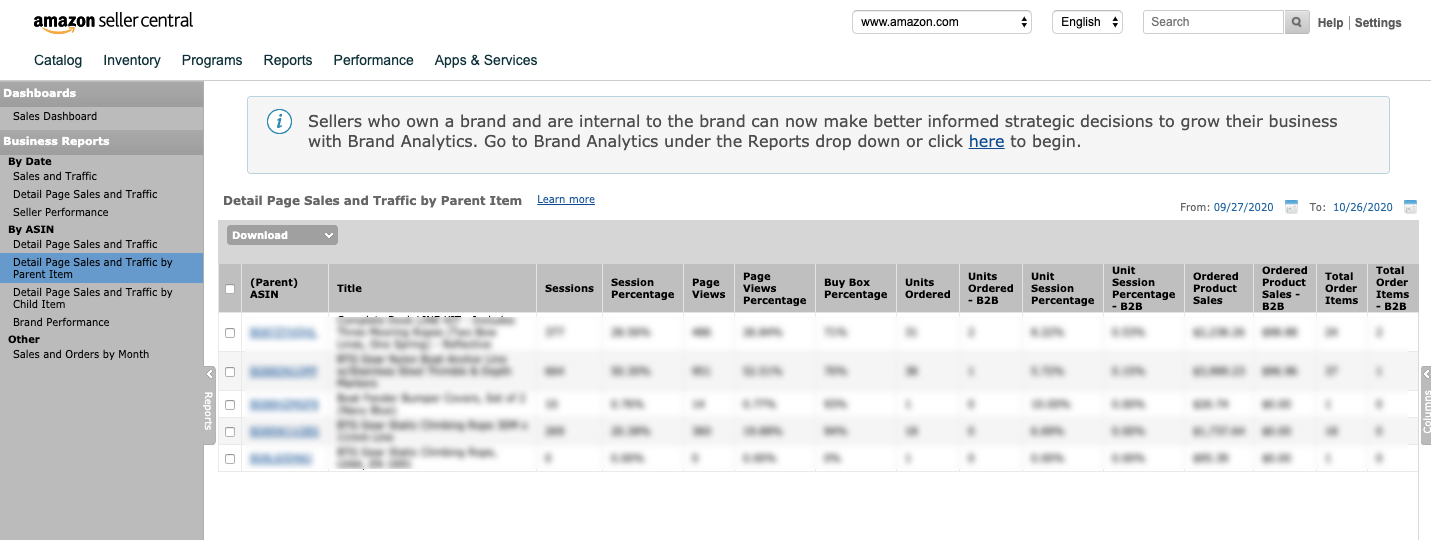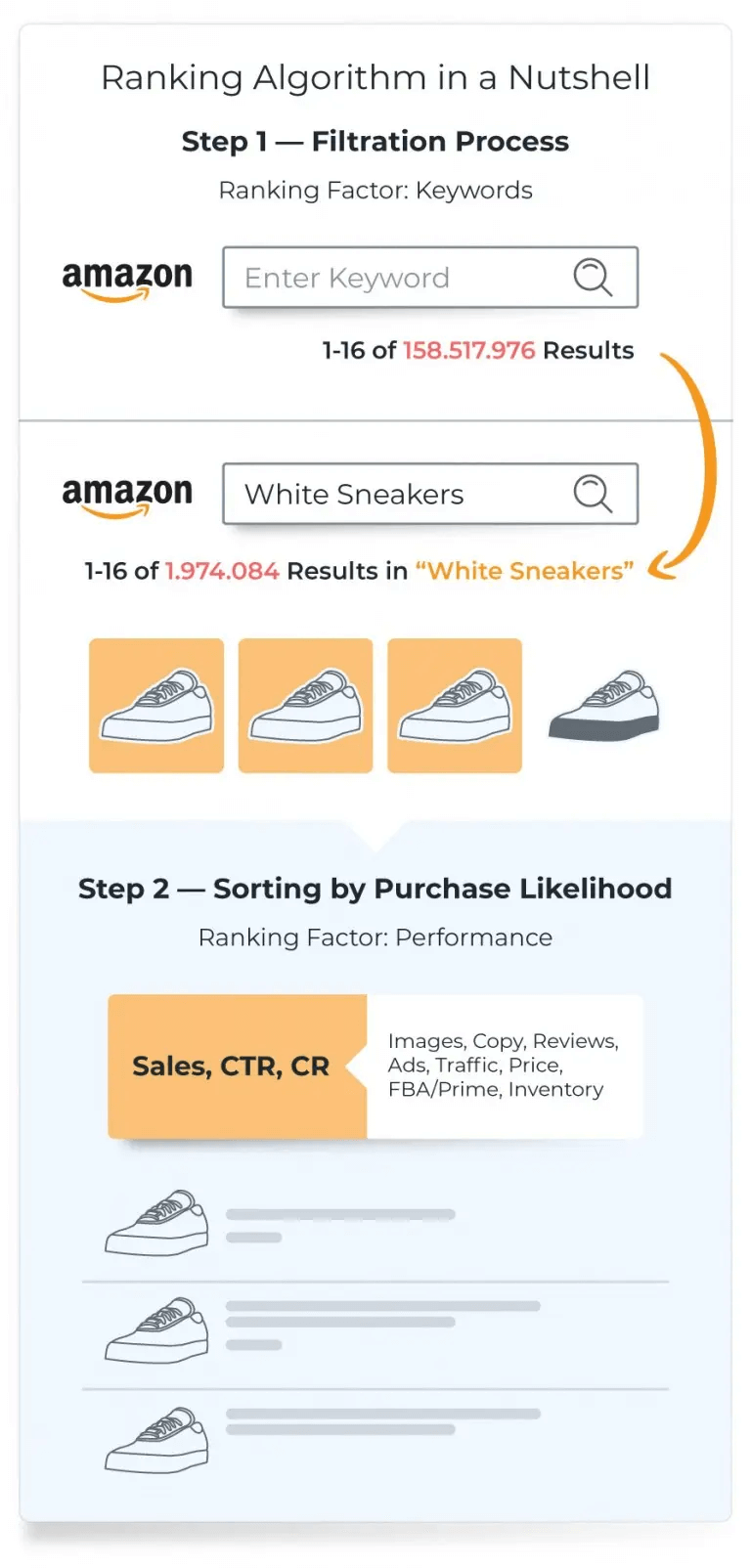
How to Boost Your Amazon Conversion Rate – Proven CRO Tips and Examples
Getting your products listed on Amazon is the first step.
Then, boosting your conversion rate is what comes next.
Because, unfortunately, if you build it – they will probably not come.
It’s harder than ever to attract potential eyeballs to your product.
On Amazon alone, there are well over 353+ million products listed. And while you can niche down to a specific, smaller audience, it can still be hard to convert a cold visitor to a customer from your Amazon listing.
They might be looking for product information that’s not visible in your listing. Or they’re not even finding your product listing organically because it’s not SEO-optimized.
Now, you probably already know the importance of a high conversion rate and how you could be getting a higher ROI on your sales and paid ads.
So, instead, we’ll just be focusing on practical ways to boost your Amazon product conversion rate. We’ll be taking a look at examples and other practical how-to you need to keep in mind.
Here’s what we’ll cover:
- How to Find and Track Your Amazon Conversion Rate
- Amazon Product Headline: Boost Your Clickthrough-Rate
- Amazon SEO: Ranking Highly for Amazon Searches
- Highlighting Your Product’s Benefits
- Designing a Product Pricing That Converts
- Consider Promoting Your Amazon Products With PPC
Ready?
Let’s begin!
How to Find and Track Your Amazon Conversion Rate
First, to get a baseline of your business, it’s a good idea to start with your current conversion rate.
Then, you can compare it to your niche benchmark or start running A/B tests to see how it’ll increase (or decrease).
Either way, the only way to know for certain what’s working and what isn’t within your CRO is through data.
Now, finding your Amazon conversion rate is a bit different from calculating your eCommerce conversion rate.
But because you’re managing your products and handling your info natively through Amazon, it’s actually easier to check your product’s conversion rate.
Here’s where to find that info:
- Open your main Amazon menu and go to Reports.
- Click Business Reports.
- Under Business Reports, click on Detailed Page Sales and Traffic by Parent Item under By ASIN category.
- Next, write down your Total Order Items number for the product you’re interested in, and divide that by the number of your Sessions, including those who left and returned.
In other words, the formula to calculate your Amazon product conversion rate is:
Conversion Rate = (Total Orders)/(Total Product Listing Sessions)

Average Amazon product conversion rate
Now that you have your Amazon product conversion rate, you’re probably wondering what to do with that number, right?
Is it good? Bad? Can it be improved?
Well, according to AdBadger, the average conversion rate on Amazon is around 9.55%.
But it’s important to put this in context. Because, conversion rate, like all other metrics, is widely different in each niche.
For example, more expensive products on Amazon ($100+) will typically have a lower conversion rate as customers like to shop around and compare products first. Meanwhile, cheaper products on Amazon might have a higher conversion rate if people can instantly find what they’re looking for.
But it’s also important to take into consideration your bigger eCommerce website and general brand.
Consider applying some of the conversion rate optimization strategies to your website too.
Now, let’s take a look at some other ways you can boost your Amazon conversion rate.
1. Amazon Product Headline: Boost Your Click Through-Rate
When optimizing your Amazon product listing, it’s best to start with your headline. As that’s the main thing that drives clicks.
We’ve covered this briefly in our landing page best practices, but it’s the same idea here.
An effective headline captures a visitor’s attention and entices them to click on your Amazon product.
Hint: If you’re out of headline ideas, consider looking up and starting with some headline templates. You’ll find a lot of them online.
Another thing you might have noticed is that no one on Amazon writes just the product name in the headline and calls it a day.
If you’ve ever looked up anything on the site, you’ll know that people go out of their way to include as much information and relevant keywords in the headline as possible.

Though this might look like keyword stuffing, this tactic definitely works.
Because, people looking up general products on Amazon (e.g. iPhone case, skincare moisturizer, etc.), are probably looking for something more specific.
It could be a waterproof phone case or an SPF moisturizer.
Then, this could be the main thing that drives clicks from the general Amazon search result page to your product description page.
And that brings us to the next step of optimizing your Amazon conversion rate.
2. Amazon SEO: Ranking Highly for Amazon Searches
So, Amazon SEO can be a bit complicated and time-consuming process. So, we’ll try to summarize it briefly.
Just like on Google, buyers on Amazon start their buyer’s journey by entering a relevant keyword to find what they’re looking for. And just like on Google, users mainly click on the first few results and rarely click on anything beyond the second, third, or any further pages.
This means that if you’re selling on Amazon, your rankings are one of the most important steps in boosting your conversion rate.
The higher you rank – the more you sell.
Now, the most important part of the equation:
How DO you boost your Amazon product SEO?
Well, long story short, Amazon has to determine the purchase likelihood not just for every product, but for every combination of product and search query.
Sounds confusing?
To put it into simpler terms, Amazon follows a two-step process for their SEO.

Source: Sellics
So, to optimize your product listing for higher rankings, you need to watch out for:
- Content – Copywriting (title, bullet points, description), images, enhanced content, etc.
- Keywords– Based on product research and other keywords people look up in order to find your product.
- Maintenance – Reviewing and tracking your Amazon conversion rate, price management, external traffic, shipping & FBA, inventory management, and more.
So, to recap this step:
Amazon SEO = optimized product listing description = more visibility = more sales.
Be sure to check out our guide to user-experience for CRO and SEO for more information and practical steps you can apply to your Amazon listing SEO too.
3. Highlighting Your Product’s Benefits
Another simple Amazon conversion hack is to focus on your product’s benefits.
If you want shoppers to buy your products, then you need to show how your product benefits them.
Obvious, right?
Meanwhile, most people get caught up on focusing on product features, instead of the benefits.
Ideally, you’d like to include both in your Amazon product description.
Features to qualify buyers so people know what they’re buying (e.g. “25 Feet HDMI cable.”).
Benefits to convince them they need this product and give them the extra nudge to make the purchase (“can reach across most rooms, ideal for events.”).
You need to demonstrate how your product can help shoppers.
To get started with that consider these questions:
- What problems do your shoppers have?
- How does your product resolve that problem?
- What makes your product a better solution than your competitor’s?
Then, consider some of our proven conversion rate optimization strategies too. Things like scarcity, social proof, and trust badges can also help greatly with boosting sales from your Amazon products.
4. Designing a Product Pricing That Converts
Your pricing is an important part of your product conversion strategy.
Too low and potential customers might have some doubts.
Too high and people might click off to find cheaper competitors.
It’s like asking if $150 is cheap or expensive?
The answer?
“Well, it depends on the product.”
Then, your brain might come up with a comparable product as a price anchor.
It turns out you can plant this anchor in your customer’s brain too.
To find the sweet spot for your product’s pricing that boosts your conversion rate, consider some proven pricing page strategies that convert, such as:
- Using a 3-tiered pricing strategy.
- Highlighting a preferred pricing option.
- Continue making A/B tests in your pricing to boost your conversions.
- Interviewing your customers and ask how much they’d be willing to pay for your product. Consider doing competitive research too.
- Reduce anxiety and add trust signals to get more people to buy.
5. Consider Promoting Your Amazon Products With PPC
Finally, promoting your Amazon products via ads and PPC is another technique for boosting your conversion rate.
With PPC, you can create ads for your products and brand. You can also maximize your real estate in search results, as paid ads appear at the top of search results.
So, this should be the final step of your conversion rate optimization journey, once you’re done optimizing your product description, writing clear benefits, and adding high-quality pictures.
Amazon offers a few advertising options:
- Sponsored brands – To advertise 3 products and appear at the top of search results.
- Sponsored product ads – To advertise one product and appear above organic search results.
- Product display ads – To advertise one product and appear on product detail pages.
The main advantage of PPC is that you only pay per click. You don’t pay for impressions or when a shopper sees your ad. This feature can help maximize your ad spend and boost your ROI too.
Conclusion
So, to recap, let’s go over some of the top questions when it comes to Amazon conversion rate optimization.
- What is a good Amazon conversion rate?
On average, a good conversion rate is around 9.55-15%. This, however, doesn’t take into consideration any additional factors which might make your conversion rate acceptable or not. Additionally, the conversion rate differs from industry to industry. So, your conversion rate should be analyzed within the proper context.
- How do I increase my Amazon conversion rate?
To optimize Amazon product listings as well as improve your conversion rate, you can:
- Optimize your product headline for a higher clickthrough rate.
- Write thorough product descriptions, content, keywords, and do regular SEO maintenance to see what’s working.
- Highlight your product’s benefits in your bullet points through clever copywriting.
- Design a product pricing system that makes sense for your customers and offer them a few options when making a purchase.
- Consider promoting your products with Amazon PPC ads so you get more real estate when listing your products.
- How do I find my Amazon conversion rate?
To find your Amazon conversion rate, you can:
- Open your main Amazon menu and go to Reports.
- Click Business Reports. Under Business Reports, click on Detailed Page Sales and Traffic by Parent Item under By ASIN category.
- Next, write down your Total Order Items number for the product you’re interested in, and divide that by the number of your Sessions, including those who left and returned.
In other words, the formula to calculate your Amazon product conversion rate is:
Conversion Rate = (Total Orders)/(Total Product Listing Sessions)
But it’s important not to lose track of your own eCommerce website conversion rate.
Get started on your CRO journey today!








 To get started, please enter your details below
To get started, please enter your details below
0 Comments